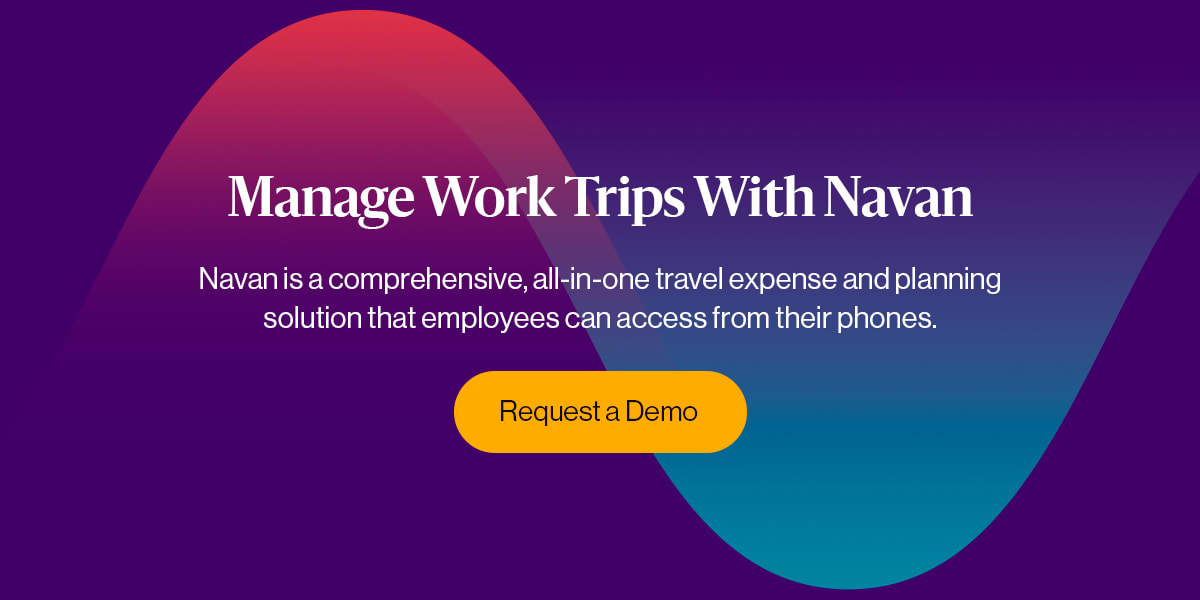How Is Per Diem Calculated on Travel Days?

Business travel management is a complicated dance of flights, hotels, meals, and managing business travel costs between meetings — from short cab rides and coffees to steak dinners and entertainment with dozens of clients in a foreign city.
While larger costs can be easier to set within a well-tailored corporate travel policy, few elements are as nuanced and distinct as per diem.
Per diem refers to the daily allowance that a company designates for business travelers to cover expenses, often including transportation, hotel, meals, and incidental expenses. Per diems can vary across companies.
Few factors directly affect business travelers’ hour-to-hour decisions on the road as much as per diem. It is also one of the areas where travel managers can exercise the most control over travel budgets through detailed reporting and visibility. Per diem rates and how to handle expense reporting after the trip are major factors in travel policy adoption rates. Per diem is also one of the most contested parts of business travel after a trip, with business travelers itemizing and submitting their receipts and travel managers or finance teams combing through one by one to ensure they're within policy.
The Ins & Outs of Per Diem Travel Days
Company leaders are responsible for determining the set per diem available to business travelers. Some business travelers might have price limits on the flights and hotels they select, and parameters on how much they can spend on food and transportation outside of those larger purchase decisions. While flights and hotels are often paid directly by the employer, business travelers typically have to expense the other day-to-day costs.
Some employers go with a fixed per diem or a set daily allowance that employers pay business travelers regardless of how much they spend. It is then the business traveler’s decision as to whether they’ll take themselves out to a steak dinner at the closest bar or pocket some money by picking up fast food.
The actual numbers are determined by the destinations frequented by business travelers and how much the company is willing to invest in the business travelers’ experiences on the road. Behind-the-scenes, a fine-tuned business travel operation will ultimately save costs, allowing the company to put more money towards making sure their business travelers are safe and productive while on the road.
Per diems are set because designated travel expenses become tax-deductible business expenses. Typical tax-deductible business travel expenses include all transportation including planes, trains, buses, and rental cars, as well as short trips with taxis or ride-share apps. It also includes luggage costs, meals, lodging, and incidentals.
When Per Diem Goes Wrong
Getting the per diem wrong within the context of a poorly designed travel policy or by using an outdated travel management solution can end up ultimately costing a company more money.
In the past, travel management had achieved its goal of cutting costs at the expense of traveler satisfaction, transforming the business trip from an opportunity into a dreaded source of employee frustration and a top cause of tension with management.
In the hopes of lowering costs, improving reporting, and streamlining the travel process, companies would bring in a travel management platform to impose policy. While these strict policies seemed to lower travel costs by forcing employees to spend within policy, they often actually achieved the exact opposite as a result of primitive or overly rigid platforms.
Employees felt trapped in a system that caused them frustration and delivered a negative experience when traveling for work. When employees do not adopt the current solution in place, they find ways to use alternative sites and book outside the system. Corporate travel managers and administrators lose time and resources as they sort through complaints, poorly submitted expenses, and out-of-policy spend.
This doesn’t mean that per diems should be unlimited and depend on business travelers’ discretion alone. But it is important to partner with a business travel management company that understands the importance of traveler satisfaction as much as the company dollar. The goal is to develop a corporate travel policy—and set per diem—alongside a technology provider that helps business travelers not only get where they need to be, but to create an environment where employees feel relaxed and happy, so they can focus on what they need to accomplish while there, rather than the process—and expenses—associated with getting there.
Expensing Is Critical to Per Diem Calculation
Manual expensing is one of the worst elements that corporate travel managers can bake into their corporate travel policy. Not offering or integrating with the latest expense management technology is among the top five travel policy deal breakers. It is frustrating and time-consuming—during and after the actual business trip.
Any road warrior can tell you that business travel challenges don’t stop when the return flight hits the tarmac. Legacy travel platforms and programs often create additional roadblocks when it comes to travel expensing and reimbursement processes.
Travelers and especially road warriors should be able to expense on the go automatically. This can be easily fixed by leveraging the latest in expense management technology, which will launch your company’s travel program into the future.
Navan allows travel managers to program proactive policies into the app so that expense management is automated, from swipe to reconciliation. Employees simply swipe their card or snap a picture of their receipt via the Navan mobile app and expenses are instantly auto-categorized.
Road warriors can organize their expenses quickly and easily on-the-go, and finance teams won’t have to deal with months-old invoices, ensuring better visibility and control into travel spend.
Calculate a Per Diem Based on Today’s Travelers
When calculating a per diem, it is important to reflect the reality of business travel today. An outdated perspective on business travel does not include peer-to-peer sharing services. However, the use of sharing economy apps among business travelers is increasing, and we're seeing more efforts to integrate such services into corporate travel policies and tools.
With automatic expensing services for business users from Lyft and Uber, the path to integration into corporate policy is well established.
If you want to learn more about how to calculate per diem for your business travelers, and partner with technology that makes it easy and efficient for business travelers and travel managers, get in touch today.
This content is for informational purposes only. It doesn't necessarily reflect the views of Navan and should not be construed as legal, tax, benefits, financial, accounting, or other advice. If you need specific advice for your business, please consult with an expert, as rules and regulations change regularly.
More content you might like
Take Travel and Expense Further with Navan
Move faster, stay compliant, and save smarter.




